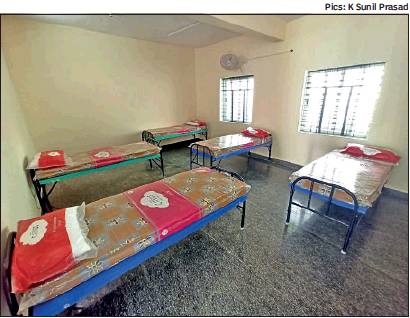SPACE CONSTRAINT Officials Say Facility Can’t House More Than 30 Illegal Immigrants At A Time
Sondekoppa (Nelamangala taluk): Villagers of Sondekoppa, 40km northwest of the city and in Nelamangala taluk of Bengaluru Rural district, now have an albatross around their neck: an L-shaped 28-year-old building standing on a half-acre plot and in disuse for over a decade. Once a hostel for backward class, Scheduled Caste and Scheduled Tribe students of a nearby government school, the building has been renovated to house Karnataka’s first detention centre for illegal immigrants, drawing national attention to the villagers’ discomfort.
Set to be formally opened soon, the centre is in focus in the wake of the furore generated by the controversial Citizenship (Amendment) Act 2019 and proposed National Register of Citizens. In the villagers’ parlance, the building is a “sub-jail for foreigners” and they are resenting the associated attention.
No one from Sondekoppa had imagined that the building meant for a hostel would lodge illegal immigrants one day, said Ravi Kumar, a villager, adding that they wanted it to offer facilities which would better their lives but no one heeded their pleas.
The building stands on the outskirts, off the main road leading to the village. According to village records, it was built in 1992 for SC/ST and backward class students. But the hostel strength dwindled every year and it had to be shut in 2008. The locked building soon wore a decrepit look. No one knows when and how it was chosen to house a detention centre, the villagers said.
According to the social welfare department which owns and maintains the building, the centre can accommodate not more than 30 immigrants at a time.
Krishnappa, 60, who has witnessed transformation of the place, said the building came up in a gundu thopu (grazing land). “When the hostel was constructed, everyone welcomed the move as students coming to the village school would benefit. People were reluctant to send their children to school as the area recorded frequent leopard attacks. They were happy to send them to the hostel. However, as leopards sightings decreased, so did student numbers in the hostel,” he said.
Krishnappa, a marginal farmer, also worked as a guard when the building was in disuse till City Armed Reserve (CAR) took over on December 10. After Bengaluru police commissioner Bhaskar Rao visited the building on November 4, it was renovated.
The structure comprises six rooms, three of which are spread over 10×15 sqft and have been converted into dormitories. Each dormitory already has five beds. It has two 10×8 sqft store rooms.
The 25-gunta plot is covered by a 10-ft compound wall, which is protected by concertina (barbed) wire. The fifth room houses three Indian commodes, five urinals and four bathrooms equipped with geysers. Two rooms and a toilet are being built for housing office and staffers. Solar lighting, borewell, a 2,000-litre overhead tank and UPS are already in place. Vijay Kumar, who was once a warden at an SC/ST and backward class hostel, has been appointed the caretaker.
Chandra Naik U, secretary, central relief committee of social welfare department, said eight months ago, they were informed by police that the building would be converted into a detention centre. Accordingly, changes were made. “Police and FRRO officials will take care of the detentions, while the social welfare department will be in charge providing food and fulfilling other needs of the occupants,” he said. The department has already appointed a warden, assistant warden, cook, clerk and other staffers.

MAKING ROOM: (Top) The detention centre has three dormitories, each of which contains five beds. (Above) The toilet and bathroom facilities
NO SEPARATE QUARTERS, TOILETS FOR WOMEN
Officials said the centre came into existence after the Karnataka high court directed the state government to open it while hearing a case pertaining to the arrest of 15 illegal Bangladeshi immigrants in August 2018.
The ministry of home affairs (MHA) in 2019 issued a manual to state governments to establish detention centres for illegal immigrants. According to the manual, the facility must be outside the premises of a prison and should have electricity with back up, drinking water, beds, sufficient toilets and bathrooms. Food must be provided and the centre should have drainage and sewage facilities, security and separate quarters for men and women.
The manual also prescribes creche facilities for young children of detainees and access to education for older kids. Recreational facilities have also been prescribed. However, the Nelamangala centre doesn’t have separate toilets and bathrooms for women, creche and recreational facilities.

Leave a Reply